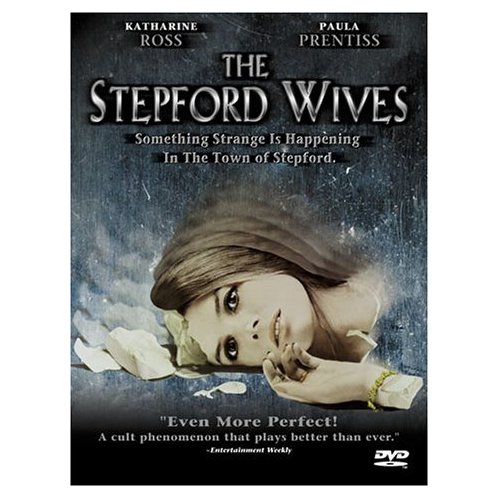Dir. Bryan Forbes
Starring: Katharine Ross, Paula
Prentiss, Peter Masterson, Nanette Newman
There must be something in the
water in Stepford. It is an idyllic Connecticut Manhattan
Too perfect. The women of
Stepford waltz around in pinafore dresses and sunhats talking about the best
cleaning products to use like they are Nanette Newman off the Fairy Liquid
adverts. In fact one of them is
Nanette Newman from the Fairy Liquid adverts! Newcomer Joanna Eberhart
(Katharine Ross - best known as Elaine Robinson from The Graduate) soon makes cause with the rebellious Bobbie Markowe (Paula
Prentiss). “It’s like maids have been
declared illegal, and the housewife with the neatest place gets Robert Redford
for Christmas.” They try to empower the local women (“pan-scrubbers” and “hausfraus” according to Bobbie) by
organising a women’s lib session to get them to open up; the concerns that emerge,
however, are guilt that they did not do any baking that day because they were
so busy polishing the floors to a shine. The session denigrates into a
discussion about the merits of Easy-On Spray Starch. Even Joanna and Bobbie’s
ally Charmaine (Tina Louise) seems to have a personality transplant, ceasing to
criticise her husband, sacking her maid, and allowing her tennis court to be
dug up to make way for a pool. Meanwhile the men – including Joanna’s husband
Walter (Peter Masterson) – are bonding well up at the Stepford Men’s
Association.
Bobbie starts to suspect that
there must be something in the water that is making the women meek and
submissive – some run off from the town’s biochemical industries. They get a
sample of the water tested; results come up negative. But then Bobbie comes
back from a weekend away with a new wardrobe, bigger boobs and a passion for
housework and Joanna gets scared. She becomes convinced that the behaviour of
the womenfolk is not just birds of a feather flocking together or some local
chemical imbalance. She starts to think that somehow the Men’s Association is
behind it all… But by the end of the film when Joanna meets the other Stepford
wives in the supermarket everything seems to be “fine”.
 |
| You'll just die if you don't get that recipe: Nanette Newman (right) shows how to cook up the perfect Stepford wife |
The phrase ‘Stepford wife’ is now
common parlance. It is used to criticise overly domestic women, those whose
ambitions stretch no further than keeping a clean home, a contended husband and
a well-cared-for family. In the 1970s when the film was shot, and when the
original novel by Ira Levin was published, a wife of this sort was probably
seen as a good attribute. Today it all seems weird – far too Desperate Housewives. But with the ‘70s
being the age of women’s lib this film really strikes a chord. The men of
Stepford are in turns piggish, calculating and malevolent. Their only redeeming
feature really is the fact that they don’t want other women, they only want
their wives. Just better versions of their wives. Meanwhile we see women with spark,
individuality and ambition have it all drained out of them. In Revolutionary
Road Revolutionary
Road
One odd thing that bears noting
is that The Stepford Wives seems to
have been a real family shoot. Nanette Newman was married to the film’s English
director Bryan Forbes. One of Joanna and Walter’s daughters actually was played
by the real-life daughter of Peter Masterson. This was the screen debut of Mary
Stuart Masterson, who later went on to play Idgie in Fried Green Tomatoes at the Whistle Stop Café.
What have I learnt about Connecticut
Where Revolutionary Road showed the suburbs of the aspiring middle class The Stepford Wives shows the homes of
those who have succeeded and have money – historic three-storey detached
properties with acres of land, set back among the trees, often with pools or
tennis courts. This is a snobbish place where men-only clubs survive and hold
power. The fact that Stepford is seen as ‘liberal’ by some townspeople just
because it had the first Chinese restaurant in Fairfield county and it is about
to have a black couple move in speaks volumes about quite how WASP-ish society
is around here. Yet nearby Westport
Can we go there?
What, you still want to go to Connecticut
Like Revolutionary Road Connecticut :
Darien , Fairfield ,
Norwalk Norwalk , the Lockwood-Mathews Mansion Museum.
The local shops can be found in the intriguingly-named Goodwives
Shopping Center in Darien
Overall Rating: 3/5
Overall Rating: 3/5

No comments:
Post a Comment